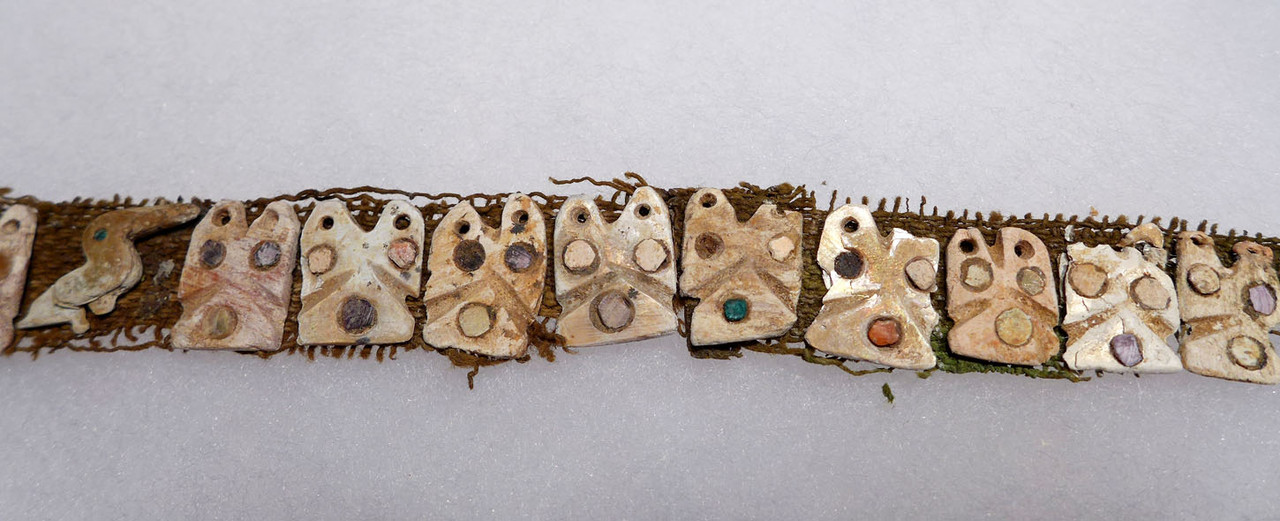Product Description
Complete pieces of jewelry from the ancient world are extremely rare when in this level of intactness. Furthermore, examples of organic materials rarely survive making this an impressive offering! This is a complete woven textile necklace choker with a multitude of carved and inlaid shell appliques affixed to the fabric. This shell textile choker dates back to a period from 800-1200 A.D. and is attributed to the ancient Pre-Columbian Chimu Culture.
The amount of work that would have gone into this piece means it would have only been worn by a very wealthy person of nobility and status. Each applique was carved from Mother of Pearl shell with inlaid eyes and other decorations of carnelian, turquoise, and Mother of Pearl. The appliques seem to mostly resemble owls or cats with a central applique of a bird. Only a few appliques are missing but the very end appliques are intact which show the entire design of graduated carvings. Imagine how long it would have taken to make this amazing object of ancient body adornment! The time required to carve and inlay EACH of the 24 appliques must have been extremely time-consuming! It must have been a stunning object of status when new over 1000 years ago!
Unlike most Pre-Columbian jewelry seen for sale, this specimen has NOT been enhanced with any modern dye or re-sewing or restored in any way.
SEE MORE PRE-COLUMBIAN ARTIFACTS
HISTORY
The Chimú culture arose about 900 AD, succeeding the Moche culture, and was later conquered by the Inca emperor Topa Inca Yupanqui around 1470, fifty years before the arrival of the Spanish in the region. The Chimu culture was centered on Chimor with the capital city of Chan Chan, a large adobe city in the Moche Valley of present-day Trujillo, Peru. The Chimú occupied a strip of desert on the north coast of Peru. The rivers in the region carved a series of fertile valley plains, which were very flat and well-suited to irrigation. Agriculture and fishing were both very important to the Chimú economy.
Worshipping the moon, the Chimú, unlike the Inca, considered it more powerful than the sun. Offerings played an important role in religious rites. A common object for offerings, as well as one used by artisans, was the shell of the Spondylus shellfish, which resides only in the warm coastal waters off present-day Ecuador. Associated with the sea, rainfall, and fertility, Spondylus shells were highly valued and traded by the Chimú people, and the exchange of the shells played a significant economic and political role in the empire.
The western coastal desert region of South America is considered the most arid place on our planet. Because of this, it has protected ancient objects in near perfect preservation where most other regions of the world would have claimed them to rot and decay. One of the most famous historical artifacts of Pre-Spanish archaeology in this region is ancient textiles of the former native American empires that once thrived there over 1000 years ago. Preserved as if many were made just yesterday, these woven textiles shed amazing insight on the mind, beliefs and practices of this ancient peoples. In their world, these woven fabrics were prized greater than gold or silver. The possession of these colorful and intricately woven textiles were a show to all that their owners were amongst the most noble and richest members of the society of that day.
The ancient textiles of this region and peoples were made up of hand spun and woven fibers. These fibers were either cotton or the wool of indigenous camelids that included the llama, alpaca, guanaco and vicuna. Some textiles were made of dyed fibers, used alternatively with different colors to create patterns. Some textiles were woven of a few or single primary color with the design hand-painted on the cloth after the weaving was completed. Other textiles were embroidered and even appliqués of shell, gemstones, gold or silver were added within the weaving.
 US DOLLAR
US DOLLAR
 EURO
EURO
 AUSTRALIAN DOLLAR
AUSTRALIAN DOLLAR
 CANADIAN DOLLAR
CANADIAN DOLLAR
 POUND STERLING
POUND STERLING


















